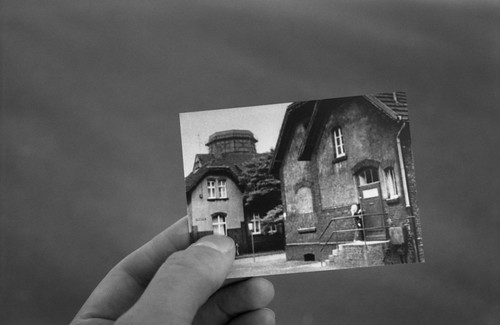
"When the policemen were questioning me, I remembered that mommy and I used to live in Wuppertal when I was little. Not grandma. The police looked it up and I was right. And mommy's name wasn't Van Dam, but Krueger. And then I remembered- I told this to the police- that we always took the train to grandma. It couldn't have been very far because we always got back the same night. And when grandma read to me, the pages rustled as she turned them because tiny bits of coal came through the window. And then the policemen said it was very simple- grandma lived in the Ruhr district."In Bulmker Park last year, in the rain, after walking as far as I had dared from Gelsenkirchen Hauptbahnhof, I realised I would not have enough time to reach Erdbrüggenstrasse, the location of Alice’s grandmothers’ house from Alice in the Cities, and returned to the station in order to catch a connecting train for my ICE service to Hamburg. Incomplete, my improvisation having failed, I knew I would one day return to Gelsenkirchen. It was also the point where I realised that this project would become bigger than I had initially planned. This had started as two points on the route of a railway journey where I could find the locations of two of Wim Wenders’ films from the 1970s as I made my way to Stockholm; in Wuppertal last year, finding the cafe where Alice remembers, “Grandmother never lived in Wuppertal,” felt significant, but I had not adequately planned how I might get to Gelsenkirchen to find Alice’s grandmother’s house the same day.
"The Ruhr district."
"Is that big?"
"Not particularly. We'll manage it."
After Philip leaves Alice with the police in Wuppertal, he goes to a Chuck Berry concert, where a brief snippet of Berry playing ‘Memphis Tennessee’ is cut into Philip sat on the ground in the audience. Returning to Sonnborner Strasse by car after dark, as he parks outside the hotel, Alice appears, having run away from the police station, and gets into the passenger seat: “Now I know where grandma lives."
"You do? Then we'd better get out of here"
After leaving Wuppertal at night, there’s a cut to a brief scene in daytime. Alice wakes from the back seat of the hired car. Philip is seated at a picnic table studying a road atlas. Behind is a view from the top of a hill: prominent in this view is the large gas holder that still remains as a landmark in Oberhausen. The background presence of Oberhausen brings to mind the famous manifesto of a decade before Alice in the Cities, announcing “Papas Kino ist tot,” but it also returns Wenders to his adolescence: “The last years of high school I spent in the Ruhr region, at the Freiherr-vom-Stein-Gymnasium in Oberhausen-Sterkrade.” (Wim Wenders, ’Talking About Germany’). After making his early films first as a student, then as a professional in Munich, followed by The Scarlet Letter, with locations in Spain standing in for New England, it’s notable that all three of the road movies trilogy touch on familiar landscapes for Wenders. As well as the sequences of Alice in the Cities around the Ruhr, Wrong Move takes Wilhelm from the mouth of the Elbe to Bonn and follows the Rhine past Boppard and Osterpai (“…that long climb, you see in the distance the small town of Boppard where my mother was born and where I spent a great part of my childhood, immediately after the war.” Wim Wenders, 'Le Souffle de l’Ange'), and even Kings of the Road, which roughly traces the border between West and East Germany, has its motorbike and sidecar diversion to the island on the Rhine that was Bruno’s childhood home. Perhaps with a familiar landscape, Wenders felt comfortable enough to take risks in form and narrative. As they breakfast on the hill above Oberhausen, Philip tells Alice that there’s a lot of Kruegers in the Ruhr district: “We'll have to know your grandmother's first name.”
"Grandma." [a pause] "Didn't I show you the photo?"The photographs that Alice produces apparently show Alice when younger, the house, and one of Lisa Kreuzer that, from its background, was taken in New York, like a reminder to Wenders himself. Was this revelation always planned? Or is the reason that the photograph of Alice’s grandmother’s house, apparently previously forgotten, first appears here, due to the improvisational methods of Wenders’ film-making adopted with Alice in the Cities? Comparison of the photograph that Alice produces here, and the scene when they find the house, shows an almost identical image, the angle of view a little different, but the foliage on the trees is the same (in the fiction of the film, the photograph of the house is from at least two years previously). This emphasises the possibility that the photograph was shot at the same time the scene was filmed, that the location was not previously found and photographed at an earlier point in the film’s production.
"What photo?"
"I didn't show it to the police and forgot about it."
"That makes things very easy."
There’s a fade in from black to them driving. Philip, Wenders' alter ego, reveals to Alice he lived in the Ruhr as a child and went to school there.
"Where are we going first?"Alice places the photographs on the hired car’s dashboard like votive offerings, echoed by Robert's photo of home at the beginning of Kings of the Road two years later. There follows a series of lyrical scenes of driving, alternating shots of Alice and Philip inside the car, with shots from the car as subjective perspectives. On a road with houses similar in style to that shown in Alice’s photograph, Philip stops to talk to an elderly couple sitting under a tree. They explain that all the houses are to be pulled down to make way for a hospital (surely the present Alfried Krupp Krankenhaus in Essen). As they drive on, Alice describes the condemned buildings as “house graves”. In the distance we can see the heavy industry characteristic of the area. The next time they stop, Alice shows the photograph to a group of children while Philip photographs a sign on the wall forbidding ball games. This is cut to a shot of a Turkish couple crossing the street, looking at the camera, with the edit constructing the spatial relations as if they are looking at Philip taking the photograph; the woman wraps her headscarf tighter around her face. Wenders shot Alice in the Cities in 16mm with a small crew, and a small budget, which would seem to lend itself to elements of documentary. Everything appears to have been shot on location, none of the interiors appear to have been constructed on a sound stage, and external reality beyond the fictional narrative keeps bleeding into the film.
"Essen."
"Good, I'm hungry."
In moments like these, Alice in the Cities illustrates Siegfried Kracauer’s “haphazard contingencies.” Wenders knew Kracauer’s writings from his time reviewing films for Filmkritik, and indeed quoted from Kracauer’s Theory of Film in his review for Once Upon a Time in the West (‘From Dream to Nightmare’). Theory of Film in its British edition, as opposed to the American version, is titled more fundamentally perhaps, Nature of Film, but both share the book’s subtitle: The Redemption of Physical Reality, which itself echoes a number of statements Wim Wenders has made about making films. Kracauer lists five ‘Inherent Affinities’ which define film: The Unstaged, The Fortuitous, Endlessness, The Indeterminate, and The “Flow of Life”. His last category, the clumsily titled “Flow of Life”, finds its greatest expression in the street “in the extended sense of the word”; here the onlooker finds “indeterminate figures”: “Each has a story, yet the story is not given”. In these sequences of Alice in the Cities, we see these figures, “the passer-by who may never again have been filmed,” as Kracauer quotes Eisenstein about the early films of D. W. Griffith, referring to, amongst others, The Musketeers of Pig Alley. Now, rather than just existing for me as a descriptive reference to a hundred year old film - and a single still - in a fifty year old book (and Eisenstein himself recalls the passerby, from a film he had seen twenty years earlier), through its digital dissemination, suddenly, from entering its title into a search engine, I can view the passerby in The Musketeers of Pig Alley once more.
Back in the car, they pull up parallel to another car and ask a cab driver: "Definitely not in Duisberg. Maybe in Oberhausen." As they begin to pull away he adds: ”Hey wait! It could be in Gelsenkirchen. On Erdbrüggenstrasse”. The subtitles however give this as Erdbrueckenstrasse, which was a brief stumbling block in my research. They drive to Oberhausen first, where the short sequence with a boy on a bike, riding parallel to the camera, occurs as written about by Brenda Austin-Smith and which I referenced in 'Alice’s Gaze', and becomes one of Kracauer’s “haphazard contingencies”.
There then follows a brief interlude in their search. They stop to take photographs of themselves in a photobooth, and do a series of exercises, copying the diagrams and instructions on a sign by the parked car. Despite having seen plenty of films eschewing a conventional narrative drive, when I first saw Alice in the Cities, I did feel as though I was waiting for something to happen for long stretches - without fully appreciating something was happening on the screen in front of me all the time. From the moment Philip meets Alice’s mother in New York, the two main characters are present for almost the entire duration of the rest of the film, with virtually every shot being understood to be constructed around them. Writing about his own experience of making The Scarlet Letter, which featured Yella Rottländer and Rüdiger Vogler, and thus the germ of Alice in the Cities, Wenders states that “every film is also a documentary of itself and the way it was made.” Robert B. Ray, in ‘Snapshots: The Beginnings of Photography’, quotes Godard with almost exactly the same sentiments: “…the cinema, which, as Jean-Luc Godard has pointed out, always provides, at the very least, a documentary record of a particular moment’s objects and people: as Godard said about his own Breathless, ‘This film is really a documentary on Jean Seberg and Jean-Paul Belmondo.’” Alice in the Cities is really a documentary on Yella Rottländer and Rüdiger Vogler.
Returning to their car, Alice now sits in the back, while Philip drives with a map on the steering wheel, Philip saying to himself “…in Erdbrüggenstrasse”, turning right from the long, curving section of the road, stating “This must be it,” to a straight, tree lined street, with houses on either side. Alice is shown looking at the photobooth strip, looking here at images of herself and Philip together at potentially the very point that the two must part; significant too, is that this last section of the car journey is filmed from Alice's viewpoint, looking out from the back of the car, to see where they have just been, the road disappearing into the past of the vanishing point. The car turns left at the end of this straight section of the road, passing a house on the corner.
"Stop! That's it!"
"What?"
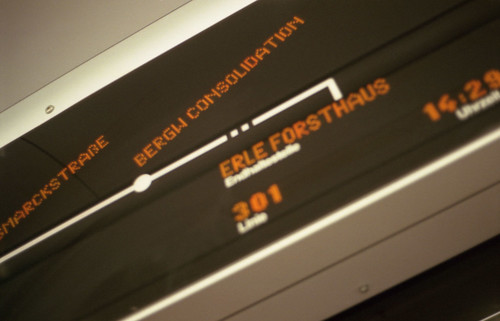
Unlike last year’s inadequately planned and abortive detour to Gelsenkirchen on my way to Hamburg, written about in ‘Improvisations’, a little more research into the area’s public transport shows a U-Bahn, Line 301, from Gelsenkirchen Hauptbahnhof running to Essener Strasse; a stop named Bergwerk Consolidation appeared to be the closest to the western end of Erdbrüggenstrasse. With no Google Street View, looking at the area online before leaving, I identified where I thought the house was by examining the shapes of roofs in the satellite imagery. Crossing Consol Park from the U-Bahn station, I could see across open ground to the far side some houses that appeared very similar stylistically to those seen in the film; a footpath from the park took me onto Kanalstrasse. Ahead, on the corner of Kanalstrasse and Erdbrüggenstrasse was Alice’s grandmother’s house.
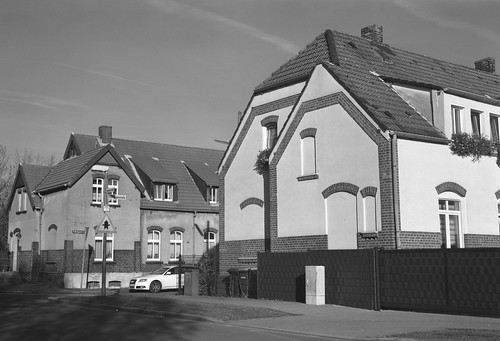
In the film, there’s a straight wall on the opposite side of street, where Philip pulls up the car. Today this is the edge of Consol Park, named after Bergwerk Consolidation (which can be translated simply as ‘Consolidated Mines’). Perhaps it is significant that it’s the very last house on Erdbrüggenstrasse, with the entrance to the house itself on Kanalstrasse, and the approach in the film is shot from the rear of the car to emphasise this reveal as the car swings around the corner, bringing it into view. Notably, the door and windows on the side of the house are now filled in, and the trees visible in the film are no longer there, but, although the definition of the film means that the road sign on the house in the background is unable to be read, it’s surely the same enamel sign. Last year I had the constraint of a train to Hamburg to meet; although the day had become bright and sunny as I travelled south from Hamburg, by the time I reached Gelsenkirchen, then had emerged from the U-Bahn at Bergwerk Consolidation, the shadows were already becoming long, the clocks having gone back the day before; in the hour that I was there, the shadows of the trees from Consol Park stretched across Kanalstrasse and onto the walls of Alice’s grandmothers house itself.
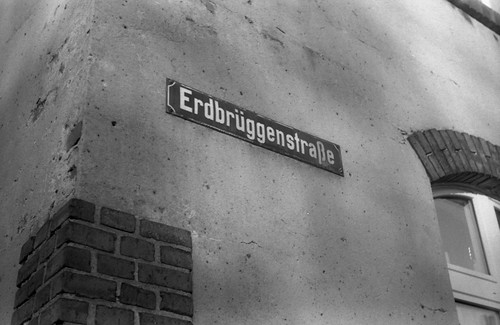
"An Italian woman lives there. She says she's been there two years. She doesn't know anything about grandma."With the equanimity of a child living in the present, Alice gravely nods to Philip's, “now we can go swimming”. There is no great sense of disappointment: Alexander Graf, in The Cinema of Wim Wenders, describes Philip to be “rather relieved to have found the house corresponding to the image: whether or not the grandmother still lives there is irrelevant, the house may no longer be the grandmother’s house, but it is concretely there. Winter is relieved, above all, because he has learnt something about the nature of the relationship between images, stories and real experience, and because the story does not have to end here.” From the point of leaving the airport in Amsterdam, the plot of the last third of the film can be summed up in a few sentences surrounding the search for the house: it drives the narrative but provides no resolution and creates the situation for an open ending. Each time the two protagonists in Alice in the Cities should be separated - at the police station, finding Alice’s grandmother’s house, meeting the police on the ferry crossing the Rhine, at the railway station afterwards - they are brought back together, and the camera leaves them in the final shot leaning out of the window of the train taking them to Munich.
“If the work of a film director can be characterized by one essential trademark, for Wenders this would be the open form, the gaps, the lack of closure. […] The stories do not propel the films forward; they merely prevent them from falling apart. It is rather the detours, the subplots, and the wrong tracks that predominate and create space for the unexpected. The frame that the camera imposes on the images does not restrict our look but rather enhances it. Linking seemingly random events to an intelligible reality, the camera discovers, and therefore creates something new.”
Norbert Grob, ‘“Life Sneaks out of Stories”: Until the End of the World’
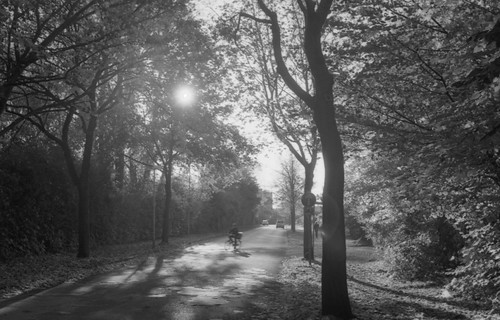
After photographing Alice’s grandmother’s house, I walked along the straight stretch of Erdbrüggenstrasse. All the trees outside the houses seen in the film are now gone, but retracing the direction of the car journey in reverse, there is a section of the road approaching the junction, where the trees return and there’s a space between the houses looking over some fields; at the corner, a young man cycled past on a bike, a small reminiscence of the boy on the bike from the sequence in Oberhausen. Returning across Consol Park, back towards the U-Bahn station, I took some photographs of the winding gear tower which can be spotted in the film in the shot across the open fields between the houses, then part of an industrial horizon that accompanies Alice and Philip’s search. Decommissioned during the 1990s, much of the infrastructure has been demolished, some preserved as monuments to the mining industry, some repurposed, such as for the Consol Theater. The area surrounding these buildings has been landscaped into a park: there’s no coal dust to be floating through windows of the houses any longer, rustling on the pages of a book.
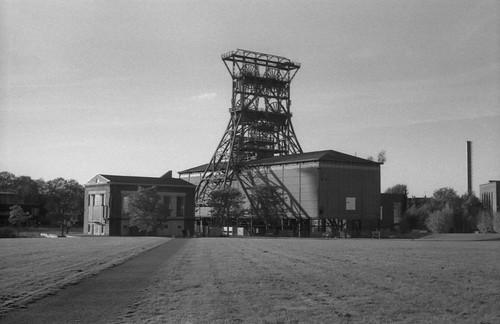
In The Remembered Film, Victor Burgin states how the “experience of a film was once localized in space and time, in the finite unreeling of a narrative in a particular theatre on a particular day. But with time a film became no longer simply something to be ‘visited’ in the way one might attend a live theatrical performance,” and quoting from his own In/Different Spaces:
“a ‘film’ may be encountered through posters, ‘blurbs’, and other advertisements. such as trailers and television clips: it may be encountered through newspaper reviews, reference work synopses and theoretical articles (with their ‘film-strip’ assemblages of still images); through production photographs, frame enlargements, memorabilia, and so on. Collecting such metonymic fragments in memory, we may come to feel familiar with a film we have not actually seen.”During the preparations for my journey last year, I found the photocopy of a magazine article, ‘The Road from Wuppertal’, from twenty years earlier, taken for an essay but not used. Attempting to discover Burgin’s “metonymic fragments” in my own memory, in my impressions of that time, I had constructed in my mind a version of Alice in the Cities from this, from the two images of the film that that illustrated the article, a cityscape framed by a windscreen, and Alice sitting on the bench in the police station. These fragments also included drawing inferences from the two films that I could see then, Paris, Texas, and Wings of Desire, and from reading Wenders’ descriptions of his working methods in ‘Impossible Stories’. Many years later I saw the film in my local cinema; after another interval of some years, seeing the film again on DVD. Although Alice in the Cities can be divided in two, with the flight from America to Europe placed almost exactly at the midpoint of its running time, the importance of the European part of the film grew for me - looking at the railway routes across Germany, to take me from Brussels to Hamburg and the train ferry onwards to my eventual destination of Stockholm, I was suddenly struck by the thought: what would it be like to be in Wuppertal? To take the Schwebebahn to Sonnborner Strasse, to experience the ‘phantom ride’, to emerge from the station there, to be sat in the window of the cafe where Alice and Philip sat forty-two years before? Robert B. Ray’s instructions for a new form of film studies (from ‘How a Film Theory Got Lost’) seem apt: “Select a detail from a movie, one that interests you without your knowing why. Follow this detail wherever it leads and report your findings.” This seemed reason enough to direct my route across Europe.
Victor Burgin, The Remembered Film
Current technology, years later, makes a close reading of the filmic text possible in such a way as at one time would only have been available to the privileged position of one sat at an editing console. Being able to still the film to photograph it from a screen enabled me to make my own version of the photograph of Alice’s grandmother’s house. I printed this in the darkroom, and took this photograph with me to Gelsenkirchen. I photographed myself holding this photograph, standing by the side of the road in Kanalstrasse, shot on motion picture film with a still camera. There was a gap, a number of days of not knowing if I had a sufficient image of the photograph being held: using a rangefinder camera with a close up supplementary lens, I could neither see to accurately frame, due to parallax, nor focus the camera, relying on calculations made previously. The latent image then had to safely travel with me back through border security, subject to x-rays, and then the process of developing, going from negative to positive to reveal itself. (I did also photograph the close up shot of Philip's hand holding the photograph in the film, but photographing my hand holding this felt too recursive).
What began as a banal gesture to insert myself into the narrative of the film through retrospective mimicry, became also an overdetermined insistence of the photograph’s relationship to time through its many layers: by the time I have developed the photographic negative of holding the photograph of Alice standing at the door of the house, that afternoon in October is in the past; the image I am holding contains the fictional past that exists in the film, from when Alice’s grandmother did live there, which includes the present tense of the film itself in the past, and its reproduction and duplication, optical, chemical, digital; then the physicality of that past of photographing the image of the film from a screen and printing this negative onto photographic paper in the darkroom, carrying this photograph and others across Europe, to find the location where Rüdiger Vogler as Philip Winter held a photograph in a street in a town in the Ruhr in 1973, photographed by Wim Wenders - and cinematographer Robby Müller of course; however, Wenders has stated, in an interview with Steven Pill, that he “prefers to frame every shot himself, selecting which lens to use and where to position the camera, just as he would when taking photographs.” Held in a series of images, fixed into the past at twenty-four frames a second, Philip doesn’t need to stand outside his hired car with the photograph in his hand, as Alice runs to the door, but this brief shot becomes a double confirmation for the viewer, seeing the image of the house in its presence, perhaps reflecting Wenders’s experience of location shooting: "The writing is hell for me. I hate it like the plague. I like best of all making the concrete preparations: driving around, looking for locations and people, creating the film not through writing, but rather through 'experiencing it beforehand,'" (Wim Wenders, in conversation with Rainer Nolden). The banal gesture, the return of the photograph of Alice’s grandmother’s house, is a meditation on the insistence of the past in the photograph (Roland Barthes’ “That-has-been”): “This was the right place, but it is no longer”: the photograph, like all photographs, is, according to Barthes, “an extended, loaded evidence […] not the figure of what it represents (quite the converse) but its very existence” and “a temporal hallucination.”
“What can we know of the world?” asks Georges Perec in ‘Species of Spaces’:
“To cover the world, to cross it in every direction, will only ever be to know a few square metres of it, a few acres, tiny incursions into disembodied vestiges, small, incidental excitements, improbable quests congealed in a mawkish haze a few details of which will remain in our memory: out beyond the railway stations and the roads, and the gleaming runways of airports, and the narrow strips of land illuminated for a brief moment by an overnight express, out beyond the panoramas too long anticipated and discovered too late, and the accumulations of works of art, it will be three children perhaps running along a bright white road, or else a small house on the way out of Avignon, with a wooden lattice door once painted green, the silhouetted outline of trees on top of a hill near Saarbrücken, four uproarious fat men on the terrace of a cafe in the outskirts of Naples, the main street of Brionne, in the Eure, two days before Christmas, around six in the evening, the coolness of a covered gallery in the souk at Sfax, a tiny dam across a Scottish loch, the hairpin bends of a road near Corvol-l’Orgueilleux. And with these, the sense of the world’s concreteness, irreducible, immediate, tangible, of something clear and closer to us: of the world, no longer as a journey having constantly to be remade, not as a race without end, a challenge having constantly to be met, not as the one pretext for a despairing acquisitiveness, nor as the illusion of a conquest, but as the rediscovery of a meaning, the perceiving that the earth is a form of writing, a geography of which we had forgotten that we ourselves are the authors.”To Perec’s it will be I can add: and the shadows of trees on the wall of a house in Gelsenkirchen, on the last day in October, where once there was a door, no longer there, opening to a nine-year old girl, asking about her fictional grandmother, no longer there, then, one summer, forty years ago.
Georges Perec, ‘Species of Spaces’
Bibliography
Brenda Austin-Smith, ‘The Uses of Disorientation’ (http://cinephile.ca/archives/volume-5-no-2-the-scene/alice-in-the-cities-the-uses-of-disorientation/), retrieved 3/12/16
Roland Barthes, Camera Lucida, translated by Richard Howard, Vintage 1993
Victor Burgin, The Remembered Film, Reaktion Books, London, 2004
Alexander Graf, The Cinema of Wim Wenders: the celluloid highway, Wallflower Press, London 2002
Norbert Grob, ‘“Life Sneaks out of Stories”: Until the End of the World’ in The Cinema of Wim Wenders: Image, Narrative and the Post Modern Condition, Roger F. Cook and Gerd Gemünden (editors), Wayne State University Press, 1997
Siegfried Kracauer, Nature of Film: The Redemption of Physical Reality, Dobson Books, London, 1960
Georges Perec, ‘Species of Spaces’ in Species of Spaces and Other Pieces, translated by John Sturrock, Penguin 2008
Steven Pill, ‘State of Grace’, British Journal of Photography, April 2011
John Pym/Don Ranvaud,'The Road From Wuppertal/Paris, Texas To Sydney, Australia', Sight and Sound, Autumn 1984
Robert B. Ray, ‘How a Film Theory Got Lost’ and ‘Snapshots: The Beginnings of Photography’, in How a Film Theory Got Lost and Other Mysteries in Cultural Studies, Indiana University Press, 2001
Wim Wenders, ‘Le Souffle de l’Ange’, and ‘The Scarlet Letter’ in The Logic Of Images; Essays and Conversations, Faber and Faber, London 1991; ‘From Dream to Nightmare’ in Emotion Pictures, Faber and Faber, London 1991; and ’Talking About Germany' in The Cinema of Wim Wenders: Image, Narrative and the Post Modern Condition, Roger F. Cook and Gerd Gemünden (editors), Wayne State University Press, 1997
See also general bibliography
No comments:
Post a Comment